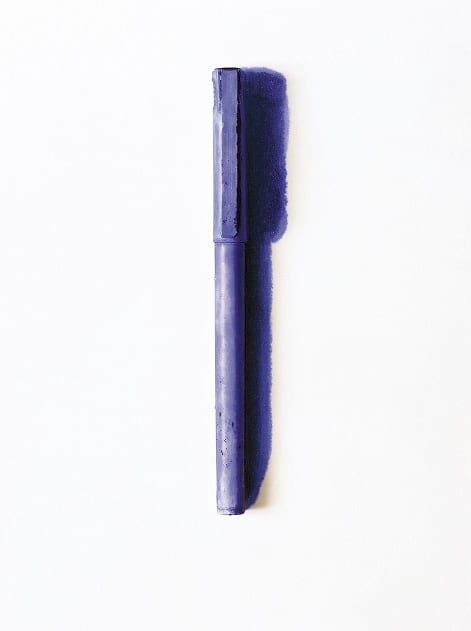
Max Creasy
Making Marks
West Space
24 August – 15 September 2012
Looking at Max Creasy’s photographs at West Space, I am confused. The room sheet tells me that they are C-type photographs, but my eye suggests something else. The subjects of the images — highlighters, markers, pencils and pens — are depicted in a manner that is sketchy and smudgy, their shadows are irregular; the brush and pen marks that describe them are too apparent.
The objects in Creasy’s photographs bear a physical resemblance to functional pens and other mark-making tools, but are in fact cast from silicon moulds, then painted: they are replicas rather than functional objects.1 Framed within a plain white background, each photograph depicts a single item from a bird’s-eye view. The use of a more traditional artform — casting — contrasts with the more modern practice of photography, and the process renders useless the seemingly mundane objects that populate the images, items more commonly found in an office drawer or stationery cupboard.
The resulting photographic images recall taxonomy — the scientific endeavour of classifying objects according to type. The titles Artliner #02 2012, Highlighter #02 2012, etc., and the arrangement of pictures into colour groups, seem to support this interpretation. However, Creasy’s colour palette — cerise, inky indigo, slate grey — denies any claim that the photographs are a naturalistic depiction and shifts away from Creasy’s previous series Paintings 2011, in which models of yoghurt containers, Stanley knives and other items were painted in colours more faithful to the objects they were cast from. The obvious hatching and irregularities of Making Marks reveals the artist’s hand and expose the process of production more than these earlier works.
It seems that production, fiction and artifice have long interested Creasy. In a previous series, Flats 2001, shot on the film set of The Bank,2 Creasy photographed backstage scenes rather than on-camera action. His images captured aspects of the film set — rigging, lighting, tangles of camera cables, temporary walls and PR photographs of the actors — the tools used to produce the fictional space of the film. The Making Marks photographs achieve a similar result: their subjects are the implements used to create an illusion — to produce shadows, highlights and a fictional light source. Both series highlight the labour-intensive work involved in producing a film or a picture.3
The ease with which Creasy navigates between different techniques and technologies reveals a clear interest in process and his proficiency across multiple mediums. His method brings to mind work by Emma White and Thomas Demand, both of whom also use sculptural replicas in their practice. Like White’s Artefact 2010, a polymer clay sculpture of a pencil sharpener and shavings, Creasy’s use of office tools references work and production — both tools of the corporate professional and also the artist. As with Creasy’s, White’s more realistic replicas leave hints about their making, traces such as fingerprints, that distinguish them from their originals, albeit more subtly.4 In contrast, Demand’s sculptural replicas show no obvious trace of their making and are therefore more convincing, while no less removed from the reality they depict.5
Creasy’s images defy easy categorisation, fusing casting, painting and photography. His intervention upon precise plaster casts disrupts the indexical relationship between facsimile and original. His use of photography adds another layer to the simulation, revealing a slippage between representation and reality.
Miri Hirschfeld works at the Australian Centre for the Moving Image, Melbourne (ACMI).
